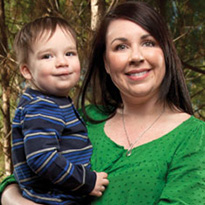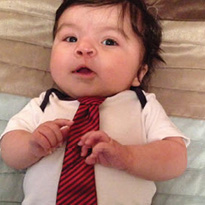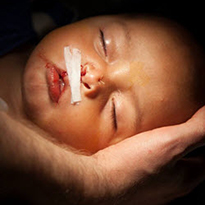Baby Genesis Overcomes Cleft Lip and Palate with Care from Children’s Memorial Hermann Hospital
“As the pregnancy went on, I was hospitalized for a few days when my blood pressure got too high.” In total, she was admitted four times.
The Pediatric Plastic and Reconstructive Surgery program at Children’s Memorial Hermann Hospital specializes in the evaluation, diagnosis, treatment and long-term management of children with congenital or acquired cleft and craniofacial conditions. Approved by the American Cleft Palate Association, our recognized cleft team specializes in the care of children needing surgery to improve the appearance and/or function of abnormal structures of the body caused by birth defects, developmental abnormalities, trauma, infection, tumors and disease.
Through our services and treatment offerings at Children’s Memorial Hermann Hospital, we care for more than 800 patients annually, distinguishing us as a leading high-volume center. We specialize in providing advanced care for children with cleft lip and palate issues, ensuring that each patient receives specialized treatment from birth through adulthood.
Our commitment to the community is reflected in our efforts to connect parents with external resources to support each family’s journey. We sponsor various events for children and families, such as the Wonderkids Workshop, Friendship Smiles, youth camps and community activities like 5K runs and family picnics. Our goal is to support families in all stages of the cleft care experience.
In addition to our clinical experience, we are deeply involved in research, keeping us at the forefront of treatment advancements. Our evidence-based care models and active participation in prospective trials demonstrate our dedication to improving outcomes for our patients. Our affiliated team has extensively studied and published in the field of cleft care, regularly presenting their findings at local and national conferences to share the latest developments.
By combining advanced clinical care, community involvement and cutting-edge research, Children’s Memorial Hermann Hospital’s Pediatric Cleft Lip and Palate program provides high-quality treatment and support for our patients and their families.
Cleft lip and palate are birth defects of the lip and mouth, known as orofacial clefts. They occur when the lip and roof of the mouth fail to fuse properly during fetal development, typically around seven weeks of gestation. In the United States, approximately 6,000 to 8,000 babies are born with a cleft lip and/or cleft palate annually, with a global incidence of 1 in 700 births.
A cleft lip is an incomplete formation of the lip, varying from a small notch to a significant gap extending to the nose. A cleft palate, less visible than a cleft lip, involves an opening in the roof of the mouth that may reach the nasal cavity and can include the lip. This defect can range from the hard palate at the front to the soft palate towards the throat. A variant, the submucous cleft palate, is covered by the mucous membrane and less obvious.
These conditions can occur alone or together, either as isolated cases or as part of genetic syndromes, often with a family history.
Cleft defects are categorized by their location and severity:
Unilateral Clefts are the most common type, affecting one side of the lip, with possible involvement of the palate. Variants include:
Bilateral Clefts affect both sides of the lip and/or palate. Variants include:
Other types of cleft lip and palates include:
The cause of cleft lip and palate involves both genetic and environmental factors, though the exact mechanisms are not fully understood. Many children born with cleft do not have associated syndromes, but there are many syndromes known to be associated with cleft. These syndromes can sometimes be detected through prenatal imaging and tested for with the guidance of a genetic counselor either before or after birth. Genetic counselors on our affiliated team can help identify genetic factors that may have contributed to your child’s condition. Common syndromes associated with cleft lip and palate include:
Often, cleft lip and palate is diagnosed during a 20-week anatomy scan, but sometimes it is not identified until after birth. Early detection, whether before or after birth, is important so that families and health care teams can prepare for any potential challenges and optimize outcomes. Our team offers prenatal consultations, both virtually and in-person, to address your questions and help you prepare for what to expect before delivery.
Generally, there are no special delivery requirements for babies with cleft lip and palate. However, we recommend parents choose a hospital equipped to assess and address your newborn's needs, including the presence of a feeding specialist experienced with cleft conditions. Once your baby is born, our affiliated pediatric team will conduct a physical assessment to evaluate your baby for any additional medical concerns.
Children’s Memorial Hermann Hospital offers a comprehensive approach to treating patients with cleft lip and palate. Our dedicated, multidisciplinary team provides advanced surgical interventions tailored to each patient’s needs. Supported by our Magnet-recognized nursing staff, we adhere to the highest standards of quality and patient safety. Continuity of care is a cornerstone of our approach, ensuring that each patient receives consistent, coordinated treatment and support throughout their journey—from initial diagnosis to surgical intervention to follow-up care. In addition, our care extends past adolescence and into adulthood with adult providers affiliated with Memorial Hermann, distinguishing us from other pediatric hospitals. This integrated strategy allows us to deliver outcomes highly specialized care designed to improve the quality of life for patients with cleft conditions.
Children born with cleft lip and palate may face several complications that could affect their hearing, speech development and feeding.
Feeding Support for Newborns with Cleft Lip and/or Palate: Infants with isolated cleft lip typically do not have feeding difficulties with breast or bottle feeding. However, babies with cleft lip and palate or isolated cleft palate struggle because the opening in the roof of the mouth prevents the suction needed for feeding. Special bottles and nipples are usually required to ensure proper feeding for hydration and weight gain. Once bottle feeding is successful, babies may breastfeed for comfort and bonding, which can stimulate milk production.
To support feeding, breast milk is recommended, if possible, as it can be beneficial for these conditions. Mothers can use specially designed nipples or pumps, and our feeding specialists can assist you with feeding methods to ensure your newborn receives sufficient milk intake and the necessary nutrients for growth and development. Children’s Memorial Hermann Hospital’s lactation consultants as well as speech and occupational therapists can help provide advanced support to ensure your child is getting the nutrients they need.
Feeding Recommendations:
Nasoalveolar Molding (NAM): This is a highly recommended pre-surgical treatment for infants with cleft lip. This technique involves using specialized devices for lip taping and molding, which significantly improves surgical outcomes and often eliminates the need for additional surgeries. NAM typically begins within the first week of life, taking advantage of the natural flexibility and growth potential of an infant’s tissues.The molding process generally continues until the child is about three months old, at which point the initial surgical repair of the cleft lip can be performed.
Ear Infections: Children with a cleft palate are prone to ear infections because the disrupted palate muscles impair fluid drainage from the inner ear, leading to fluid build-up and infection. These recurrent infections can result in hearing loss. An otolaryngologist may place ventilating tubes in the eardrum during cleft repair surgeries to help prevent fluid accumulation and reduce the risk of ear infections and hearing loss. We can coordinate surgeries to minimize separate anesthesia risks whenever possible. For example, ear tubes can be placed during palate surgery.
Speech Delays: The openings in the mouth and lip can weaken muscle function, potentially causing speech delays or abnormalities. Children with cleft conditions often face challenges including articulation issues, such as compensatory misarticulations and nasal escape during speech, which are often due to a short or dysfunctional palate. Early referral to a speech therapist is crucial for assessing and addressing these speech concerns. Our team includes speech-language pathologists who specialize in these conditions and have advanced training and experience. They can also coordinate with your school or local speech therapist to provide guidance on effective therapies.
Surgical treatments for cleft lip and palate vary by the type and severity of the cleft. Treatment plans are tailored to each patient's medical needs and typically follow a developmental timeline, involving multiple stages and procedures.
The Texas Cleft-Craniofacial Team meets monthly to assess each patient. Comprised of affiliated specialists in pediatric plastic surgery, ENT surgery, pediatric dentistry, orthodontics, audiology, speech-language pathology, genetic counseling, and a cleft and craniofacial coordinator, the team provides comprehensive, multidisciplinary care.
In addition to planned surgical care, each patient receives an annual evaluation to monitor facial growth, appearance, speech, dental needs, and overall well-being. This yearly visit allows all necessary specialists to be seen in one appointment, facilitating coordinated care and optimal treatment planning for your child.
It is crucial to keep up with these annual appointments. During these visits, we coordinate with all members of your child’s care team, including external providers. We serve as the central hub, coordinating care across all your specialists, both within our system and those closer to home.

“As the pregnancy went on, I was hospitalized for a few days when my blood pressure got too high.” In total, she was admitted four times.

Three-year-old Neal Wille is among the one in 700 kids annually around the world born with a cleft lip and palate. Today, he’s a ball of smiles and sunshine when his parents bring him to see the Texas Cleft-Craniofacial Team for follow-up care after his surgeries that were performed at Chil...

Cameron is on the “A” honor roll in his fifth-grade class, a significant achievement for any kid. Cameron is not just any kid. He is a survivor. At 10 years of age, Cameron has already undergone 24 surgical procedures. Cameron was diagnosed with an extremely rare genetic condition known as Mandib...

On April 21, 2014, Leah Yeglin gave birth to her son, Jacob. Moments later, she began to sense something was wrong – and soon learned her intuition was right. A nurse informed her that Jacob had a cleft lip but, thankfully, was otherwise healthy. “It was a shock,” Yeglin remembers. “I thought tha...

As Kenzie and Ricky attended their routine 18-week ultrasound, they expected everything to go smoothly; however, they received unexpected information about their baby girl, Macy. Their unborn daughter was diagnosed with a unilateral cleft (a split occurring on one side) that extended all the way ...

Daniella Coca’s son Anthony was born with both a cleft lip and palate. Coca was five months pregnant when she received the diagnosis after a 3-D ultrasound, which afforded her and Anthony’s father several months to meet John Teichgraeber, MD, and his team, determine a plan of action and better pr...

Pediatric surgeons have the ability to bring smiles to patients and their families. Dr. John Teichgraeber, director of the Division of Plastic and Reconstructive Surgery in the Department of Pediatric Surgery, recently brought smiles and positive outcomes to patients in Mexico as part of a medica...
Texas Cranio-facial Team and Pediatric Plastic Surgery Clinic
6410 Fannin Street, Suite 950
Houston, TX 77030
Plastic & Reconstructive Surgery Clinic: (832) 325-7234
Texas Cranio-facial Team: (713) 500-7302
To contact Children's Memorial Hermann Hospital, please fill out the form below.
If you are experiencing a medical emergency, call 911 or go to the nearest emergency room.
If you or someone you know needs support from the Suicide and Crisis Lifeline, call or text 988.